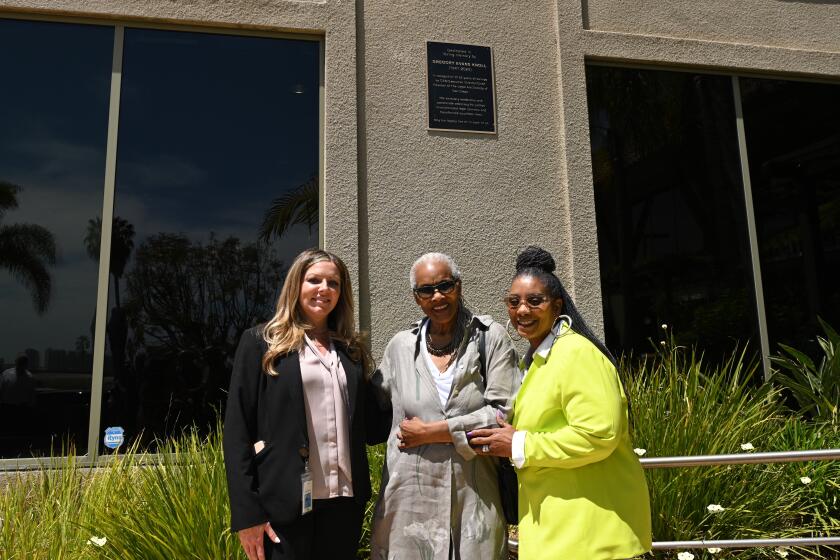New ability to post bond in illegal entry cases was undermining Trump administration’s ‘zero tolerance’ policy. So prosecutors changed tactics
On a recent Friday, a rancher from Zacatecas, Mexico, sat in a San Diego courtroom on a misdemeanor illegal entry charge, one of thousands of border crossers criminally prosecuted under the Trump administration’s “zero tolerance” policy this year.
He pleaded not guilty, and a federal magistrate judge set his bail at $1,000.
The amount likely would’ve been too high for him to post himself, but he had another option. The Bail Project, a nonprofit fundraising organization, had recently set up shop in San Diego and put up the bond money for him.
But rather than be released to the community, his unauthorized presence in the United States meant the federal government had placed a so-called “immigration detainer” on him. He was transferred to the Department of Homeland Security and quickly deported back to Mexico, before his criminal prosecution was finished.
The U.S. Attorney’s Office was forced to dismiss his case.
In recent weeks, there have been many more like the rancher who — after posting bond with help from The Bail Project — were scooped up by immigration authorities and removed before the U.S. Attorney’s Office was able to secure criminal convictions against them.
The development has frustrated the Trump administration’s zero tolerance policy, undermining U.S. Attorney General Jeff Sessions’ vow to use the criminal justice system to deter illegal immigration and tighten the Southwest border.
“This is defeating their purpose,” said attorney Jami Ferrara, who oversees the panel of private lawyers who provide public defense.
So last week, the government decided things were going to be done differently. No longer will immigration detainers be lodged against unauthorized immigrants upon arrest. Instead, if they are able to meet the conditions of bail set by a magistrate judge, they will be released to the community so they can see their criminal case through to the end.
Then, upon conviction, they would be deported. Those whose cases are dismissed for whatever reason would go into immigration proceedings.
“We are working with other agencies to ensure successful prosecution of these criminal complaints,” San Diego Border Patrol spokesman William Rogers said Friday.
Border Patrol officials declined to elaborate further, saying that they needed more time to answer specific questions about the changes and expected to be able to this week. The U.S. Attorney’s Office declined to comment, and U.S. Immigration and Customs Enforcement directed inquiries to the Border Patrol and the U.S. Attorney’s Office.
The change illustrates just how important the misdemeanor convictions are to the Trump administration.
It also raises questions as to the bail conditions that will be required of these defendants, many of whom have no ties to the San Diego area or a place to stay while awaiting their next court date.
Making a choice
The government’s current dilemma highlights the tension that can arise between the criminal justice system — in which immigration violations can be charged as crimes — and the completely separate immigration system under civil law.
This issue of detaining people in immigration custody while out on bond in a criminal case is not new. Courts around the country have ruled on various aspects over the years, with many courts coming to the conclusion that the government can’t have it both ways; it must choose between prosecution or deportation.
In United States v. Trujillo-Alvarez, the district court in Oregon ruled that a person who’s posted bail cannot be held in immigration custody for the purposes of ensuring his appearance at a criminal hearing. Rather, immigration custody was for purposes of removal or deportation.
This wasn’t an issue in the early days of zero tolerance in San Diego, which started in May, namely because most arrestees — even if granted bail — couldn’t afford it and remained in detention until their criminal cases were finished.
In San Diego, the whole process moved quite quickly due to a special court that was set up in July to handle the influx of illegal entry cases. It was modeled after “Operation Streamline” courts in other parts of the country along the border, which allowed unauthorized immigrants to plead guilty during their first court appearance, accept a time-served sentence and be deported from the country.
Then a few things changed.
One is the decision to stop taking same-day guilty pleas.
The defense bar had been arguing for months that a system that encourages unauthorized immigrants — many of whom have little understanding of the American legal system — to make such a monumental decision as to how to plead, in just a few hours and with minimal counsel from an attorney, was a violation of due process. The court earned the nickname “Operation Steamroll.”
In late September, the magistrate judges decided that the same-day pleas weren’t working and were creating a combative atmosphere in the courtroom, Ferrara said.
Those charged with illegal entry now have five days to decide whether to accept the government’s plea deal, or to go ahead to trial.
That means they are potentially in pre-trial custody longer — unless they can secure bail.
Bail fundraising
Enter The Bail Project.
The nonprofit has its origins in a pilot program attached to the public defenders office in The Bronx in 2007.
“We got to see how bail can be used to pressure people into taking guilty pleas,” said The Bail Project spokesman Camilo Ramirez.
He said more than 90 percent of the people held on bail in misdemeanor cases ultimately plead guilty. But, when The Bail Project posted bond for them, 60 percent of the time the charges got dismissed, and for the remainder, 40 percent of the time the misdemeanor was lowered to a violation.
The organization also found that 96 percent of misdemeanor defendants made their court appearances, even if their own money wasn’t on the line.
In January, The Bail Project went national, setting up offices in cities including Detroit, Compton and St. Louis at a time when bail reform is gaining widespread attention.
About a month and a half ago, the project came to San Diego to specifically aid those charged with illegal entry crimes under zero tolerance.
“We’re interested in looking at the intersection of cash bail and the criminalization of immigration,” Ramirez said.
The project has been able to post bond for about 500 unauthorized immigrants so far here. It is unclear how many of them were deported before being convicted, but defense attorneys estimate it is hundreds.
Posting bail gives defendants more time to consider how to proceed with their criminal case, including whether there is an asylum claim to pursue or how a guilty plea might affect future attempts to get legal permission to be in the U.S., Ramirez said.
“People are pleading guilty because they had no other way out (of detention),” Ramirez said.
The project runs on “revolving-door” donations — typically the same donations being used over and over again. Once a defendant’s case is over and as long as the bail conditions were satisfied, the money gets returned to the project to use in another case.
New territory
On Tuesday, the first day of no immigration detainers, the magistrate duty courtroom was especially tense as everyone waited to see how the afternoon would unfold.
Assistant U.S. Attorney Fred Sheppard argued that all of the unauthorized immigrants appearing that day — 50 in all — were flight risks and should not be granted bail.
“There is a severe incentive for them not to see these proceedings through,” Sheppard argued, citing the near certainty of deportation upon conviction.
U.S. Magistrate Judge William Gallo was inclined to grant bail, however, he grappled with the conditions that would adequately ensure appearance at future court dates.
While all the defendants had crossed the border here, few, if any, have connections to Southern California and many had farther destinations in mind.
“Where do they go?” Gallo asked, later adding that he can’t release them “to the streets.”
Federal defenders noted there were 20 beds at a halfway house contracted with U.S. Pretrial Services, the agency responsible for supervising defendants during their time out on bail. But Gallo denied requests to make use of the limited number of beds, asking what happens to defendant No. 21, 22 and so on.
“There are no good options here,” Gallo surmised.
Gallo then issued bail — $1,000 secured by a $100 cash deposit for many — but surprised everyone by requiring each defendant to find an approved “third-party custodian.” That person would agree to take responsibility for the defendant while out on bail, maybe help transport him or her to court dates and promise to report any violations of release conditions to the court.
Robert Swain spoke for many of the defense attorneys in the room when he told the judge that in his 30-or-so years of practice, he’d never come across a third-party custodian requirement.
“The times they are a-changin’, Mr. Swain,” Gallo quipped.
Ferrara said it was unclear what criteria would be used to approve the custodians. By late Friday, none of the defendants had been able to find such a person.
“There shouldn’t be a bail condition that amounts to detention,” said Kasha Castillo, a supervisor at Federal Defenders.
And while these were the conditions under Gallo last week, another rotating magistrate judge will hear illegal entry cases this week.
“Every week is a different battle,” Ferrara noted.
Meanwhile, the defense bar has been working to partner with local advocacy groups that would serve as third-party custodians and help provide shelter to those who do get out on bond.
Defense attorney Marc Levinson, who watched from the gallery Tuesday, likened the legal wrangling to a game of human chess.
“It’s tough to watch,” he said. “It’s hard to see the rules seemingly being made up on the fly.”
Ramirez, from The Bail Project, said a reaction from the government was anticipated, but what happens next is unknown. “It’s very much changing day by day.”
kristina.davis@sduniontribune.com
Twitter: @kristinadavis
The latest news, as soon as it breaks.
Get our email alerts straight to your inbox.
You may occasionally receive promotional content from the San Diego Union-Tribune.


